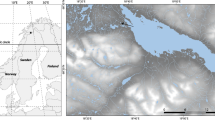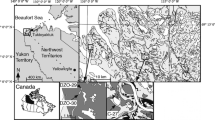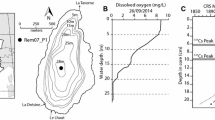Abstract
Chironomids typical of cold, well-oxygenated, oligotrophic environments are common in late-Pleistocene deposits, but these taxa are rare in Holocene sediments of most small temperate lakes. Hypotheses to explain the demise of these taxa include variations in climate, lake trophic state, lake levels, terrestrial vegetation, and/or sediment composition. In southwestern British Columbia, this demise correlates with palynological evidence for a lodgepole pine decline, and for rapid climatic amelioration, at about 10 000 yr B.P. Faunal changes are poorly correlated with lithological boundaries. The similar timing of the declines among lakes suggests that a regional influence, climate, has possibly been the principal determinant of early chironomid faunal succession.
Similar content being viewed by others
References
Bliss, L. C. (ed.), 1977. Truelove Lowland, Devon Island, Canada: A high arctic ecosystem. University of Alberta Press, Edmonton.
Brodin, Y., 1986. The postglacial history of Lake Flarken, southern Sweden, interpreted from subfossil insect remains. Int. Revue ges. Hydrobiol. 71: 371–432.
Brundin, L., 1958. The bottom faunistical lake type system and its application to the southern hemisphere. Moreover a theory of glacial erosion as a factor of productivity in lakes and oceans. Verh. int. Ver. Limnol. 13: 288–297.
Coffmann, W. P. & L. C. Ferrington Jr., 1984. Chironomidae. In R. W. Merritt & K. W. Cummins (eds.), An Introduction to the Aquatic Insects of North America. 2nd ed. Kendall/Hunt Publ., Dubuque, Iowa: 551–652.
Danks, H. V., 1981. Arctic Arthropods: A review of systematics and ecology with particular reference to the North American fauna. Entomol. Soc. Can., Ottawa.
de March, L., de March, B. & Eddy, W., 1978. Limnological, fisheries, and stream zoobenthic studies at Stanwell-Fletcher Lake, a large high arctic lake. Arctic Islands Pipelines Program, Preliminary Report 1977. Department of Indian and Northern Affairs Publication No. QS-8160004-EE-A1, Ottawa.
Deevey, E. S., Jr., 1953. Paleolimnology and climate. In H. Shapley (ed.), Climatic change: Evidence, causes, and effects. Harvard Univ. Press: 273–318.
Donald, D. B., D. J. Alger & G. A. Antoniuk, 1985. Limnological studies in Jasper National Park. Part ten: The north boundary lakes. Can. Wildlife Serv., Edmonton.
Environment Canada, 1982. Canadian climate normals (1951–1980), 2, 3, 4 & 6. Atmos. Environ. Serv., Ottawa, Can.
Farley, A. L., 1979. Atlas of British Columbia — People, environment and resource use. Univ. B.C. Press, Vancouver.
Günther, J., 1983. Development of Grossensee (Holstein, Germany): variations in trophic status from the analysis of subfossil microfauna. Hydrobiologia 103: 231–234.
Hamilton, A. L., 1965. An Analysis of a Freshwater Benthic Community with special reference to the Chironomidae. Ph.D. thesis, Univ. of B.C., Vancouver, B.C.
Hare, R. L., 1976. The macroscopic zoobenthos of Parry Sound, Georgian Bay. M.Sc. thesis, University of Waterloo, Waterloo, Canada.
Hebda, R. J., 1983. Late-glacial and postglacial vegetation history at Bear Cove Bog, northeast Vancouver Island, British Columbia. Can. J. Bot. 61: 3172–3192.
Henrikson, L., J. B. Olofsson & H. G. Oscarson, 1982. The impact of acidification on Chironomidae (Diptera) as indicated by subfossil stratification. Hydrobiologia 86: 223–229.
Hershey, A. E., 1985a. Littoral chironomid communities in an arctic Alaskan lake. Holarct. Ecol. 8: 39–48.
Hershey, A. E., 1985b. Effects of predatory sculpin on the chironomid communities in an arctic lake. Ecology 66: 1131–1138.
Hofmann, W., 1971. Die postglaziale Entwicklung der Chironomiden und Chaoborus-Fauna (Dipt.) des Schöhsees. Arch. Hydrobiol. Suppl. 40.
Hofmann, W., 1978. Analysis of animal microfossils from the Großer Segeberger See (F.R.G.). Arch. Hydrobiol. 82: 316–346.
Hofmann, W., 1983a. Stratigraphy of Cladocera and Chironomidae in a core from a shallow North German lake. Hydrobiologia 103: 235–239.
Hofmann, W., 1983b. Stratigraphy of subfossil Chironomidae and Ceratopogonidae (Insecta: Diptera) in late glacial littoral sediments from Lobsigensee (Swiss Plateau). Studies in the late Quaternary of Lobsigensee 4. Revue Paleobiol. 2: 205–209.
Hofmann, W., 1988. The significance of chironomid analysis (Insecta: Diptera) for paleolimnological research. Palaeogeogr. Palaeoclimatol. Palaeoecol. 62: 501–510.
Kansanen, P. H., 1985. Assessment of pollution history from recent sediments in Lake Vanajavesi, southern Finland. II. Changes in the Chironomidae, Chaoboridae and Ceratopogonidae (Diptera) fauna. Ann. zool. fenn. 22: 57–90.
King, M., 1980. Palynological and macrofossil analyses of lake sediment from the Lillooet area, British Columbia. M.Sc. thesis, Simon Fraser University, Burnaby, British Columbia.
Klinka, K., 1976. Ecosystem units — their classification, interpretation and mapping in the University of British
Columbia Research Forest. Ph.D. thesis, Univ. B.C., Vancouver.
Lawrenz, R. W., 1975. The developmental paleoecology of Green Lake, Antrim County, Michigan. M.S. thesis, Central Michigan University, Michigan, U.S.A.
Livingstone, D. A., 1957. On the sigmoid growth phase in the history of Linsley Pond. Am. J. Sci. 225: 364–373.
Mathewes, R. W., 1985. Paleobotanical evidence for climatic change in southwestern British Columbia during lateglacial and Holocene time. Syllogeus 55: 397–422.
Mathewes, R. W. & L. E. Heusser, 1981. A 12 000 year palynological record of temperature and precipitation trends in southwestern British Columbia. Can. J. Bot. 59: 707–710.
Mayhood, D. W. & R. S. Anderson, 1976. Limnological survey of the Lake Louise area, Banff National Park. Part 2 — The lakes. Canadian Wildlife Service, Environment Canada, Calgary.
Oliver, D. R., 1964. A limnological investigation of a large arctic lake, Nettilling Lake, Baffin Island. Arctic 17: 69–83.
Oliver, D. R., 1976. Chironomidae (Diptera) of Char Lake, Cornwallis Island, N.W.T., with descriptions of two new species. Can. Ent. 108: 1053–1064.
Province of British Columbia, undated. British Columbia Geological Highway Map. B.C. Ministry Energy Mines Petroleum Resour., Victoria.
Roddick, J. A., 1966. Vancouver North, Coquitlam, and Pitt Lake map-areas, British Columbia with special emphasis on the evolution of the plutonic rocks. Geol. Surv. Can, Mem. 335.
Sæther, O. A., 1970. A survey of the bottom fauna in lakes of the Okanagan Valley, British Columbia. Fish. Res. Bd Can. Techn. Rep. 196: 1–29.
Sæther, O. A., 1975a. Nearctic and Palaearctic Heterotrissocladius (Diptera: Chironomidae). Bull. Fish. Res. Bd Can. 193: 1–67.
Sæther, O. A., 1975b. Two new species of Protanypus Kieffer, with keys to Nearctic and Palaearctic species of the genus (Diptera: Chironomidae). J. Fish. Res. Bd Can. 32: 367–388.
Sæther, O. A., 1979. Chironomid communities as water quality indicators. Holarct. Ecol. 2: 65–74.
Sæther, O. A., 1980. The influence of eutrophication on deep lake benthic invertebrate communities. Prog. Water Technol. 12: 161–180.
Schakau, B. & C. Frank, 1984. Die Entwicklung der Chironomiden-Fauna (Diptera) des Tegeler Sees im Spätund Postglazial. Verh. Ges. Okol. 12: 375–382.
Wainman, N. & R. W. Mathewes, 1987. Forest history of the last 12000 years based on plant macrofossil analysis of sediment from Marion Lake, southwestern British Columbia. Can. J. Bot. 65: 2179–2187.
Walker, I. R., 1987. Chironomidae (Diptera) in paleoecology. Quat. Sci. Rev. 6: 29–40.
Walker, I. R., 1988. Late-Quaternary palaeoecology of Chironomidae (Diptera: Insecta) from lake sediments in British Columbia. Ph.D. thesis, Simon Fraser Univ., Burnaby, B.C.
Walker, I. R. & R. W. Mathewes, 1987a. Chironomidae (Diptera) and postglacial climate at Marion Lake, British Columbia, Canada. Quat. Res. 27: 89–102.
Walker, I. R. & R. W. Mathewes, 1987b. Chironomids, lake trophic status, and climate. Quat. Res. 28: 431–437.
Walker, I. R. & R. W. Mathewes, 1988. Late-Quaternary fossil Chironomidae (Diptera) from Hippa Lake, Queen Charlotte Islands, British Columbia, with special reference to Corynocera Zett. Can. Ent. 120: 739–751.
Walker, I. R. & C. G. Paterson, 1983. Post-glacial chironomid succession in two small humic lakes in the New Brunswick — Nova Scotia (Canada) border area. Freshwater Invertebr. Biol. 2: 61–73.
Warner, B. G. & B. Hann, 1987. Aquatic invertebrates as paleoclimatic indicators? Quat. Res. 28: 427–430.
Warwick, W. F., 1980. Palaeolimnology of the Bay of Quinte, Lake Ontario: 2800 years of cultural influence. Can. Bull. Fish. Aquat. Sci. 206: 1–117.
Wiederholm, T. (ed.), 1983. Chironomidae of the Holarctic region. Keys and diagnoses. Part 1 — Larvae. Entomol. scand. Suppl. 19.
Author information
Authors and Affiliations
Additional information
This is the eleventh of a series of papers to be published by this journal that was presented in the paleolimnology sessions organized by R.B. Davis for the XIIth Congress of the International Union for Quaternary Research (INQUA), which took place in Ottawa, Canada in August 1987. Dr. Davis is serving as guest editor of this series.
Rights and permissions
About this article
Cite this article
Walker, I.R., Mathewes, R.W. Early postglacial chironomid succession in southwestern British Columbia, Canada, and its paleoenvironmental significance. J Paleolimnol 2, 1–14 (1989). https://doi.org/10.1007/BF00156979
Accepted:
Issue Date:
DOI: https://doi.org/10.1007/BF00156979




